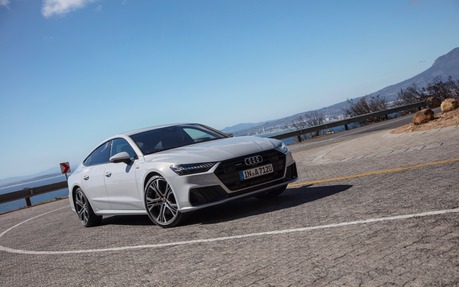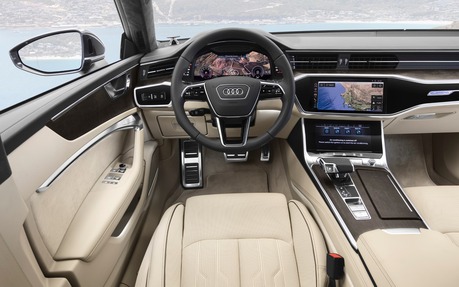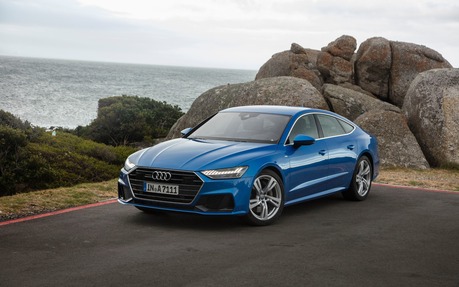2019 Audi A7: Tech Made Sexy
CAPE TOWN, South Africa – The new, second-generation Audi A7 is still a paragon of elegance, but now also serves as a technological showcase for the German carmaker, as it incorporates many new technologies first introduced on the Audi A8 uber-luxury sedan. So, tech made sexy is the buzzword for the new A7.
The recently-introduced A8 is a good-looking, albeit somewhat conservative car, but this new A7 is just drop-dead gorgeous and styling is a big part of its appeal. The Mercedes-Benz CLS may have been the first four-door coupe on the market, but the A7 is the one that truly launched the sedan-styled-like-a-coupe trend that is now so prevalent, even in lower segments, as evidenced by recent cars like the new Honda Accord and Kia Stinger.
Based on the Audi Prologue concept car, the new A7 ushers in Audi’s latest design language characterized by a wider hexagonal grille, more sculpted front and rear fascias as well as flared wheel arches to emphasize the car’s signature quattro all-wheel drive system. In the back, the new A7 keeps the retractable wing setup of the previous model, but features a new and very striking light bar taillight design with LED elements. It is instantly recognizable as an A7, but the focus of this second-generation car is now all about athletic elegance. It’s a real looker…

Turbo power and all-wheel steering
On the mountain roads near Cape Town in South Africa, the turbocharged 3.0-litre V6 delivered 340 horsepower as well as 368 pound-feet of torque on a wide plateau that ranges from 1370 to 4500 rpm. Mated to a new seven-speed, dual-clutch gearbox, and the quattro ultra on-demand all-wheel drive system first introduced on the A4 Allroad, this engine pulled strongly, giving the A7 a spirited driving feel, with the car clocking in at 5.3 seconds for the run up to 100 km/h.
The character of the A7 can be tailored via the Audi drive select system. Choose the Dynamic setting and the car will handle mountain roads with aplomb, carving corners with ease. Go to Comfort mode and feel it soak up road undulations, while providing a more relaxed and compliant ride. There is an available four-wheel steer system that will turn the rear wheels by five degrees in the opposite direction of the fronts, when the car is driven at speeds below 60 km/h, making it more agile in tight corners or when parking where this large car actually feels like the smaller A4. At speeds above 60 km/h, the rear wheels are turned in the same direction as the fronts, making the car more stable during quick lateral transitions.
The steering ratio is also variable and can go all the way from a quick 9.5:1 for rapid changes in direction to a slower 16.5:1 ratio, again making the car more stable at higher speeds. All this adds up to a very competent package delivering great driving dynamics.
48-volt electrical system and mild hybrid tech
Like the A8, the 2019 Audi A7 is built on a very rigid platform made with a mix of aluminum and high-strength steel, although the mix features less aluminium and more steel in the A7 than in the A8. The A7 is also equipped with a 48-volt electrical system and mild hybrid technology by way of a belt alternator starter and a 10-Ah lithium-ion battery. This allows the car to coast at speeds between 55 and 160 km/h with the gasoline engine off for up to 55 seconds. When the accelerator is depressed, the engine restarts automatically.
There is also a fuel-saving start/stop system that uses the front-facing camera to monitor the movement of the vehicle ahead. When that vehicle starts moving, the A7’s engine is automatically restarted. Regenerative braking of up to 12 kW is also part of the A7’s mild hybrid system. The kinetic energy is fed to the 48 volt battery to be released under acceleration to offset the turbo lag of the internal combustion engine. Combined, these fuel-saving measures account directly for a 0.7 L/100 km reduction in fuel consumption.
The new A7 is remarkably quiet at speed, which adds to the comfort level and, because the new car’s wheelbase is longer than that of the outgoing model, rear-seat passengers get an extra 13 millimetres of legroom. Cargo volume is rated at 535 litres, or 1390 litres with the rear seatbacks folded.
As with the recent A8, Audi is using a new nomenclature for the A7 that bears no relevance to engine displacement, but is meant to provide an equivalency between the power outputs of its internal combustion engines and the forthcoming hybrid-electric or fully electric powerplants. That is why the V6-powered A7 wears a 55 TFSI badge. It is expected to be joined later by a 60 TFSI model powered by a twin-turbo, 4.0-litre V8 developing 460 hp and 486 lb.-ft. of torque.

Level 3 autonomous drive capability
Like the A8, the 2019 Audi A7 is capable of Level 3 autonomous driving, meaning that it can take over completely from the driver when travelling at speeds below 60 km/h on a divided highway when the Traffic Jam Pilot system is engaged.
From a legal standpoint, it is expected that many countries will soon implement changes in legislation to authorize autonomous driving. The new Audi A7 is already fitted with all the necessary equipment to allow for Level 3 autonomous driving and it is just waiting for the rest of the world to catch up.
Digitalization in the cockpit
Like the A8, the cockpit of the second-generation A7 has gone completely digital, with most of the conventional switchgear now replaced by two very intuitive, high-definition touchscreen displays with acoustic and haptic feedback. The top 10.1-inch screen is the interface for navigation, infotainment and communication functions while the lower 8.6-inch screen is the interface for climate controls as well as the heated and ventilated seats. The 12.3-inch Audi virtual cockpit screen also replaces the conventional instrument cluster and continues to dazzle with remarkably clear graphics.
The new second-generation Audi A7 will make its way to Canadian dealerships in the third quarter of 2018 as a 2019 model, with full pricing info announced closer to launch. The new A7 is loaded with tech wrapped in a very stylish shape, and these key attributes mean that this new car will continue to be a major draw for the Audi brand.
| Test drive report | |
| Test model | 2019 Audi A7 |
|---|---|
| Trim level | 3.0 TFSI Quattro Progressiv |
| Price range | N/A |
| Price as tested | N/A |
| Warranty (basic) | N/A |
| Warranty (powertrain) | N/A |
| Fuel economy (city/highway/observed) | N/A / N/A / 10.7 L/100km |
| Options | N/A |
| Competitive models | Audi A6, BMW 5 Series, BMW 6 Series, Cadillac CTS, Genesis G80, Infiniti Q70, Jaguar XF, Lexus GS, Maserati Ghibli, Mercedes-Benz CLS, Mercedes-Benz E-Class, Volvo S90 |
| Strong points |
|
| Weak points |
|
| Editor's rating | |
| Fuel economy | Observed fuel consumption of 10.7 liters per 100 kilometers. |
| Comfort | Very quiet at speed. Very relaxed and compliant ride in "Comfort" mode. |
| Performance | The flat torque plateau of the V6 engine allows for a 5.3 second run up to 100 kilometers per hour. |
| Infotainment | The multimedia interface is very intuitive and the virtual cockpit dazzles with clear graphics. |
| Driving | The A7 is very competent in ride and handling |
| Overall | Loaded with tech and wrapped in exquisite bodywork, the A7 will continue to attract customers to the Audi brand |
